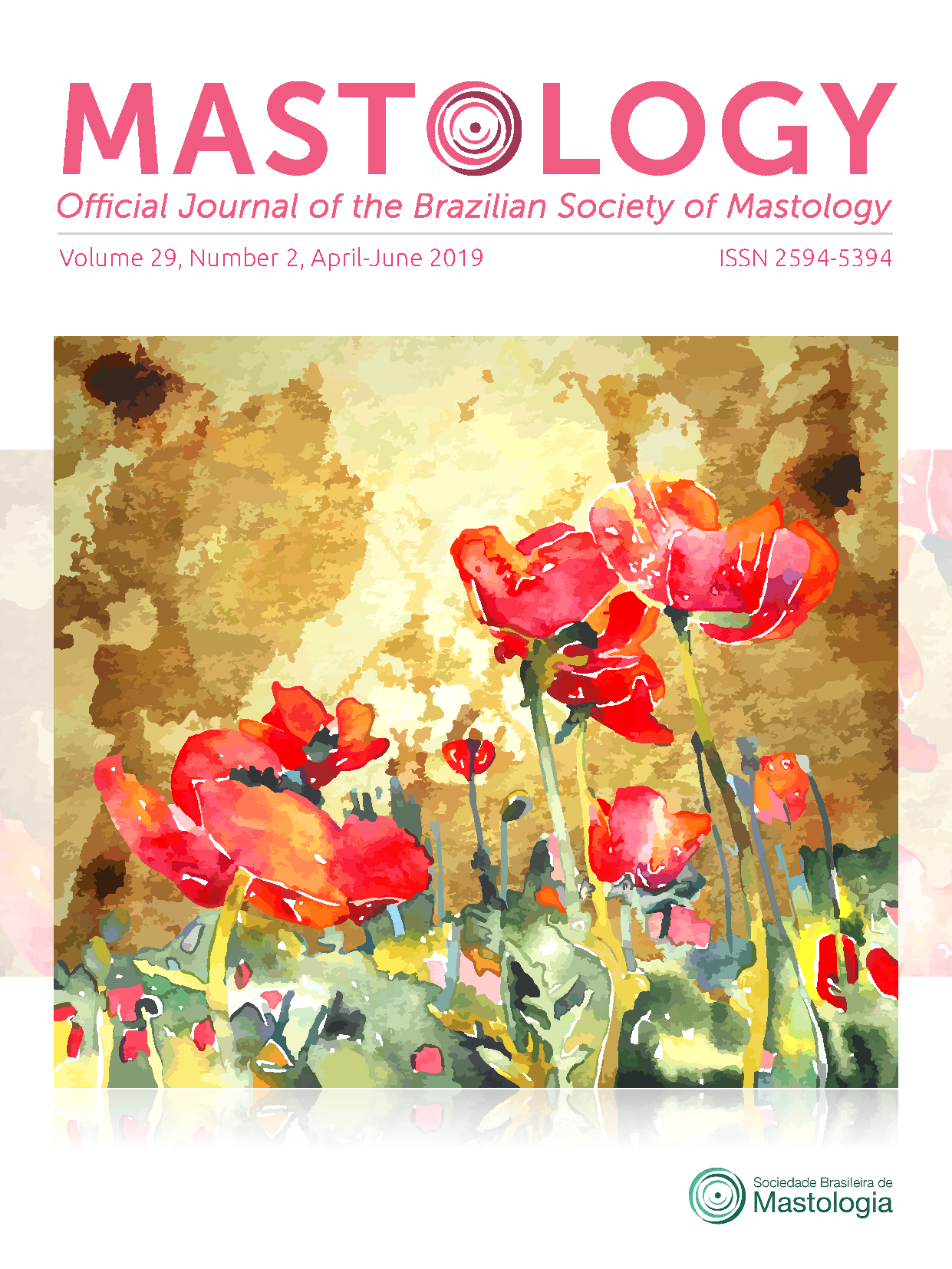EVALUATION OF IMMUNOCYTOCHEMISTRY ON THE DIAGNOSIS OF PAPILLARY MAMMARY TUMORS BY FINE-NEEDLE ASPIRATION BIOPSY
Keywords:
intraductal papilloma, fine-needle biopsy, immunohistochemistry, Ki-67 antigen; pathologyAbstract
Purposes: This study has observed the effectiveness of the immunocytochemical method on the diagnosis of papillary lesions of the breast from fine needle aspiration biopsy (FNAB), to validate the method that would avoid unnecessary excision of small intraductal papillomas of the breast when applied to clinical practice. Methods: Medical records and FNAB examinations were analyzed from 2003 to 2012 and subsequently a immunocytochemical examination was performed with p63 myoepithelial cell marker and Ki67 proliferative index, analyzing the specificity and sensitivity of the markers in the diagnosis of papillary lesions of the breast. Results: The immunocytochemistry of the papillary breast lesions material with immunomarkers Ki67 and p63 showed sensitivity of 78.6% and specificity of 73.33% in the identification of benign lesions. Conclusions: The combined use of these markers in FNAB of papillary mammary lesions helps in the therapeutic orientation of the disease, but further studies including a larger number of cases should be performed in order to have a better evaluation of this method.
Downloads
References
Pal SK, Lau SK, Kruper L, Nwoye U, Garberoglio C, Gupta RK, et al. Papillary carcinoma of the breast: an overview. Breast Cancer Res Treat. 2010;122(3):637-45. https://doi.org/10.1007/s10549‑010‑0961‑5
Willems SM, van Deurzen CHM, van Diest PJ. Diagnosis of breast lesions: fine-needle aspiration cytology or core needle biopsy? A review. J Clin Pathol. 2012;65(4):287-92. http://dx.doi.org/10.1136/jclinpath-2011-200410
Frankel PP, Esteves VF, Thuler LCS, Vieira RJ da S. Acuracia da puncao aspirativa por agulha fina e da puncao por agulha grossa no diagnostico de lesoes mamarias. Rev Bras Ginecol Obs. 2011;33(3):139‑43. http://dx.doi.org/10.1590/S0100‑72032011000300007
Aggarwal D, Soin N, Kalita D, Pant L, Kudesia M, Singh S. Cytodiagnosis of papillary carcinoma of the breast: Report of REFERENCES a case with histological correlation. J Cytol. 2014;31(2):119-21. https://dx.doi.org/10.4103%2F0970-9371.138694
Gobbi H. Classificacao dos tumores da mama: atualizacao baseada na nova classificacao da Organizacao Mundial da Saude de 2012. J Bras Patol Med Lab. 2012;48(6):463-74. http://dx.doi.org/10.1590/S1676-24442012000600013
Zhao L, Yang X, Khan A, Kandil D. Diagnostic Role of Immunohistochemistry in the Evaluation of Breast Pathology Specimens. Arch Pathol Lab Med. 2014;138(1):16-24. https://doi.org/10.5858/arpa.2012-0440-RA
Dewar R, Fadare O, Gilmore H, Gown AM. Best practices in diagnostic immunohistochemistry: Myoepithelial markers in breast pathology. Arch Pathol Lab Med. 2011;135(4):422-9. https://doi.org/10.1043/2010-0336-CP.1
Aikawa E, Kawahara A, Kondo K, Hattori S, Kage M. Morphometric analysis and p63 improve the identification of myoepithelial cells in breast lesion cytology. Diagn Cytopathol. 2010;39(3):172-6. https://doi.org/10.1002/dc.21353
Hafez NH, Tahous NS. The Role of P63 Immunocytochemistry for Myoepithelial Cells in the Diagnosis of Atypical and Suspicious Cases in Breast Fine Needle Aspiration Cytology (FNAC). J Egypt Natl Canc Inst. 2010;22(2):123-34.
Reisenbichler ES, Adams AL, Hameed O. The Predictive Ability of a CK5/p63/CK8/18 Antibody Cocktail in Stratifying Breast Papillary Lesions on Needle Biopsy: An Algorithmic Approach Works Best. Am J Clin Pathol. 2013;140(6):767-79. https://doi.org/10.1309/AJCPXV64GXLZCIGA
Parthasarathi K. Ki-67: a review of utility in breast cancer. Aust Med Student J. 2015;6(1):102–4.
Zaha DC. Significance of immunohistochemistry in breast cancer. World J Clin Oncol. 2014;5(3):382-92. https://dx.doi.org/10.5306%2Fwjco.v5.i3.382
Al-Maghraby H, Ghorab Z, Khalbuss W, Wong J, Silverman JF, Saad RS. The diagnostic utility of CK5/6 and p63 in fine-needle aspiration of the breast lesions diagnosed as proliferative fibrocystic lesion. Diagn Cytopathol. 2012;40(2):141-7. https://doi.org/10.1002/dc.21534
Tse GM, Ni Y-B, Tsang JYS, Shao M-M, Huang Y-H, Luo M-H, et al. Immunohistochemistry in the diagnosis of papillary lesions of the breast. Histopathology. 2014;65(6):839-53. https://doi.org/10.1111/his.12453
Boin DP, Baez JJ, Guajardo MP, Benavides DO, Ortega ME, Valdes DR, et al. Breast papillary lesions: an analysis of 70 cases. Ecancermedicalscience. 2014;8:461. https://dx.doi.org/10.3332%2Fecancer.2014.461
Wiratkapun C, Keeratitragoon T, Lertsithichai P, Chanplakorn N. Upgrading rate of papillary breast lesions diagnosed by core-needle biopsy. Diagnostic Interv Radiol. 2013;19:371-6. https://dx.doi.org/10.5152/dir.2013.017
Bianchi S, Bendinelli B, Saladino V, Vezzosi V, Brancato B, Nori J, et al. Non-Malignant Breast Papillary Lesions - B3 Diagnosed on Ultrasound - Guided 14-Gauge Needle Core Biopsy: Analysis of 114 Cases from a Single Institution and Review of the Literature. Pathol Oncol Res. 2015;21(3):535-46. https://doi.org/10.1007/s12253-014-9882-7
Prathiba D, Rao S, Kshitija K, Joseph L. Papillary lesions of breast: An introspect of cytomorphological features. J Cytol. 2010;27(1):12-5. https://doi.org/10.4103/0970-9371.66692
Moon HJ, Jung I, Kim MJ, Kim E-K. Breast Papilloma without Atypia and Risk of Breast Carcinoma. Breast J. 2014;20(5):525‑33. https://doi.org/10.1111/tbj.12309
Jagmohan P, Pool FJ, Putti TC, Wong J. Papillary lesions of the breast: imaging findings and diagnostic challenges. Diagn Interv Radiol. 2013;19(6):471-8. https://doi.org/10.5152/dir.2013.13041
Choi SH, Jo S, Kim D-H, Park JS, Choi Y, Kook S-H, et al. Clinical and Imaging Characteristics of Papillary Neoplasms of the Breast Associated with Malignancy: A Retrospective Cohort Study. Ultrasound Med Biol. 2014;40(11):2599-608. https://doi. org/10.1016/j.ultrasmedbio.2014.06.018
Menes TS, Rosenberg R, Balch S, Jaffer S, Kerlikowske K, Miglioretti DL. Upgrade of high-risk breast lesions detected on mammography in the Breast Cancer Surveillance Consortium. Am J Surg. 2014;207(1):24-31. https://doi.org/10.1016/j.amjsurg.2013.05.014
Kuzmiak CM, Lewis MQ, Zeng D, Liu X. Role of Sonography in the Differentiation of Benign, High-Risk, and Malignant Papillary Lesions of the Breast. J Ultrasound Med. 2014;33(9):1545-52. https://doi.org/10.7863/ultra.33.9.1545
Kestelman FP, Gomes CFA, Fontes FB, Marchiori E. Imaging findings of papillary breast lesions: A pictorial review. Clin Radiol [Internet]. 2014;69(4):436-41. https://doi.org/10.1016/j. crad.2013.11.020
Pathmanathan N, Balleine RL. Ki67 and proliferation in breast cancer. J Clin Pathol. 2013;66(6):512-6. https://doi.org/10.1136/jclinpath-2012-201085
Downloads
Published
How to Cite
Issue
Section
License
Copyright (c) 2019 Fábio Postiglione Mansani, Marina Bertucci, Mário Rodrigues Montemór Netto, Luiz Martins Collaço, Jorge Felipe do Lago Pereira dos Santos

This work is licensed under a Creative Commons Attribution 4.0 International License.







